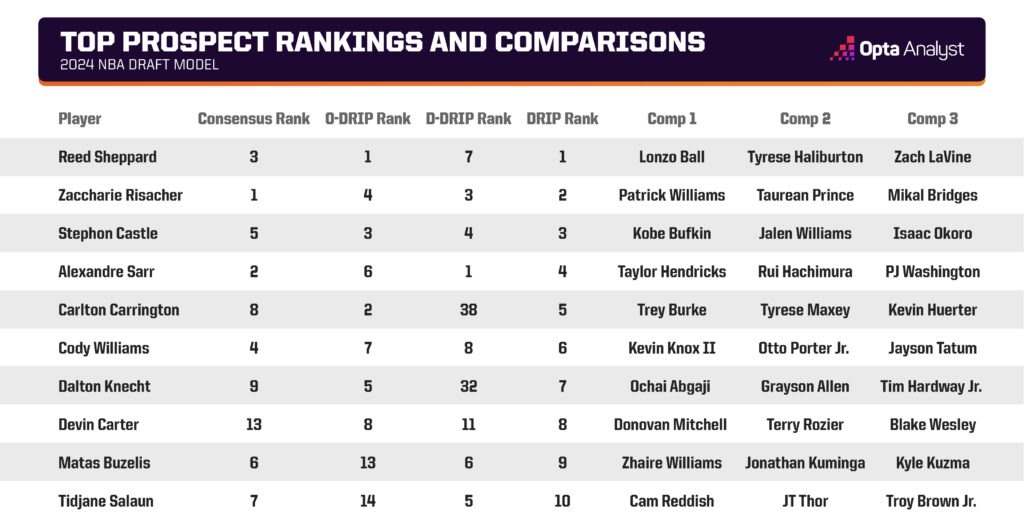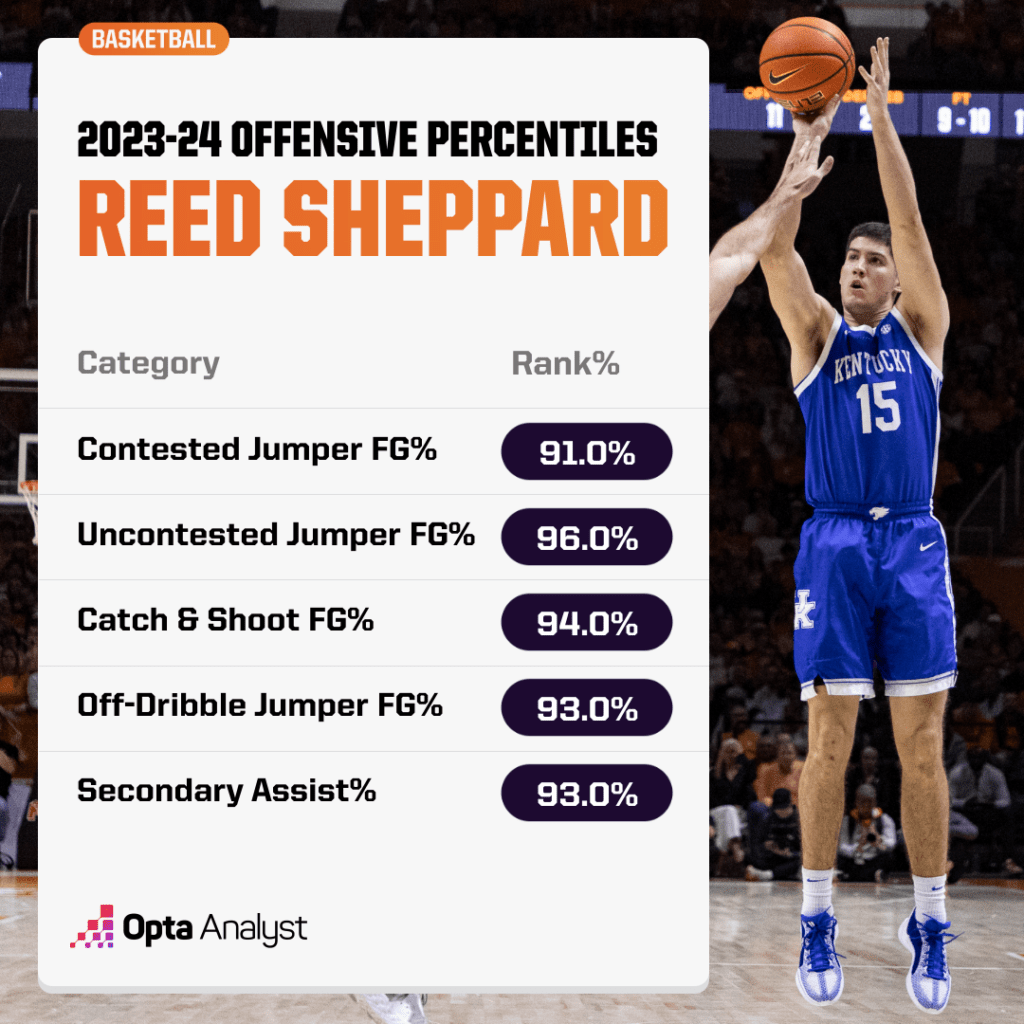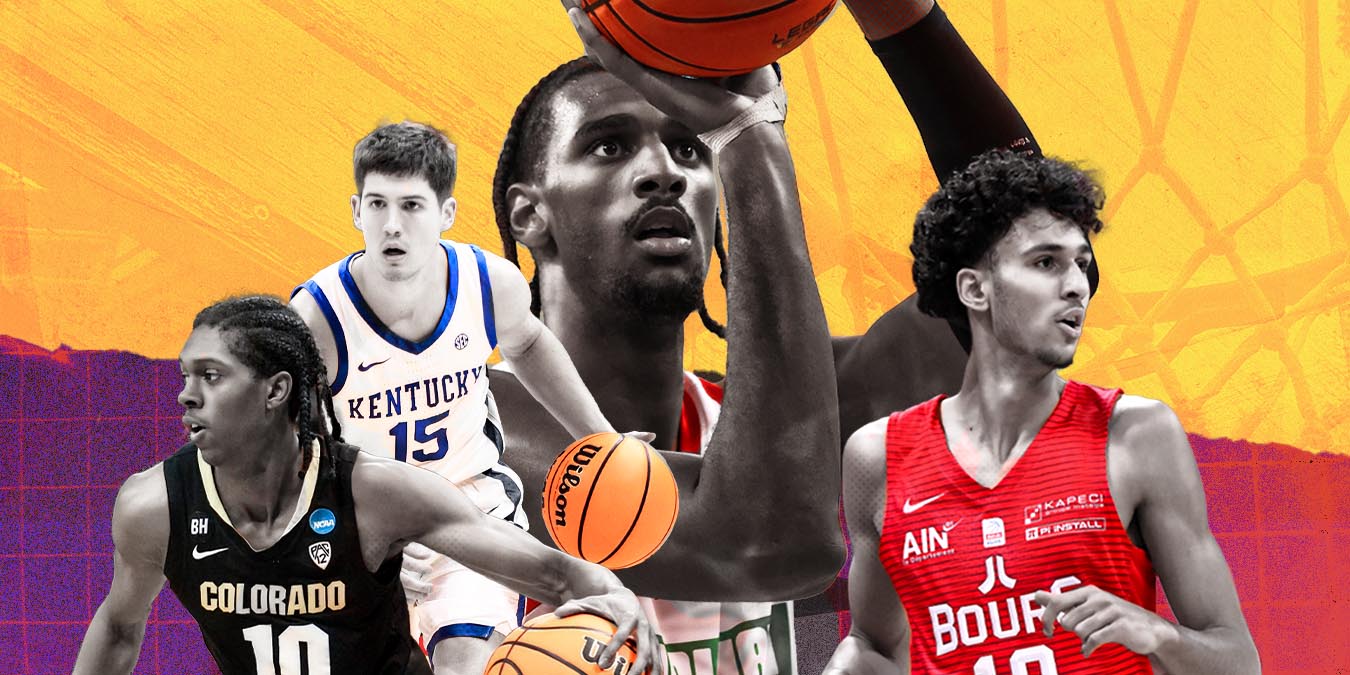There is no offseason. The Boston Celtics rolled through the playoffs and defeated the Dallas Mavericks in the NBA Finals. Now all eyes are turning to the 2024 NBA Draft.
In a mysterious NBA Draft in which there seemingly hasn’t been a consensus on anything, the race for the right to be chosen with the top overall pick is heating up.
Zaccharie Risacher from France, Alex Sarr of the Perth Wildcats in Australia and Kentucky product Reed Sheppard have emerged as the top three on most NBA mock drafts.
Yahoo!, NBA.com, CBS Sports and The Ringer all have draft gurus who expect Risacher, a 19-year-old forward, to be selected first overall (by the Atlanta Hawks) and Sarr, a 19-year-old center, second (by the Washington Wizards) when the first round begins on June 26 in New York.
Sheppard, a 6-foot-3 guard, is predicted to go third (to the Houston Rockets) on most draft boards and as far down as sixth (Charlotte Hornets) on Yahoo’s rankings.
But how does the order shake out when the rankings are generated from volume- and rate-based stats and advanced data instead of opinions on who a player reminds people of based on his body type and playing style?
We’ll tell you by revealing the rankings from our NBA Draft model, which is derived from an array of statistical inputs, consensus draft rankings and biographical/anthropometric information to determine where NCAA, G League and international prospects stand. It also incorporates tracking data from AutoStats, which uses AI-enhanced body recognition technology to identify player position and movement across the entirety of the court.
The model’s sliders can be used to emphasize certain physical and statistical traits, if you so choose. And we have the ability to set the DRIP, which is a projection of a player’s contribution to team plus-minus per 100 possessions, anywhere between Year 1 to Year 6, depending on what point in the development process we want to forecast.
For our purposes, we’ve ranked our prospects by their DRIP at the end of Year 4 because that’s when this class is set to play through its rookie contracts.
It’s also important to note that while the model’s NBA comparisons are meant to be at the time those players were entering the draft, it does open the imagination to potential projections.
Here’s a look at our model’s 10 best prospects for the draft, along with their top three player comparisons (Comp 1 being the closest):

In case you’re wondering, Ron Holland (G League Ignite), Donovan Clingan (UConn), Ja’Kobe Walter (Baylor), Jaylon Tyson (California), Terrence Shannon Jr. (Illinois), Jared McCain (Duke), Kyshawn George (Miami), Cam Spencer (UConn), Johnny Furphy (Kansas) and Tyler Kolek (Marquette) are 11th through 20th in the rankings.
How about Bronny James (USC), son of Los Angeles Lakers star LeBron James? He’s 86th. What about two-time AP College Basketball Player of the Year Zach Edey (Purdue)? He’s 28th.
Our model also isn’t as big on Nikola Topic becoming the next great Nikola out of Serbia as some of the draft experts, ranking him 47th.
But at the top, it’s not Risacher or Sarr. Sheppard holds the top DRIP at the end of Year 4. The 6-3 guard filled the stat sheet in his only season at Kentucky, averaging 12.5 points, 4.1 rebounds, 4.5 assists, 2.5 steals and 0.7 blocks while shooting 52.1% (75 of 144) from 3-point range.
As a result, he became only the ninth major conference player since 2000-01 to have at least 12.0 points, 2.0 made 3s, 4.0 assists, 4.0 rebounds and 2.0 steals per game in a season, with Tyrese Haliburton – then at Iowa State – being the last to do it in 2019-20.
So perhaps it shouldn’t be a surprise Haliburton is one of his top NBA player comparisons, along with Lonzo Ball and Zach LaVine of the Chicago Bulls.
Sheppard’s ability to light it up shows up in the data. He ranked in the 96th percentile in uncontested jumpers and in the 91st percentile in contested jumpers, per AutoStats. Catch-and-shoot jumpers? The 94th percentile. Off-the-dribble jumpers? The 93rd percentile.

Sheppard ranks first in offensive DRIP (O-DRIP) in our four-year projections, but also projects out as the seventh-best defensive player over that span.
It’s also worth noting our model ranks UConn product Stephon Castle third – ahead of the consensus No. 2 prospect Sarr. That’s in large part due to Castle projecting out as the third-best offensive player in the draft behind Sheppard and Carlton Carrington out of Pittsburgh, while Sarr is sixth in O-DRIP.
Carrington averaged 13.8 points in his lone season at Pitt, but he finished strong at 18.8 points per game on 47.6% 3-point shooting (20 of 42) over his last six. The 6-5 point guard’s offensive potential is evident in his player comparisons, with the Philadelphia 76ers’ Tyrese Maxey coming up as one of his closest.
Colorado freshman Cody Williams, another one-and-done prospect, has been referred to as the most intriguing players of the draft. And indeed, the 6-8 forward’s projections are all over the map.
Williams averaged 11.9 points on 55.2% field-goal shooting while playing 28.1 minutes per game over 24 contests in 2023-24. He had a nine-game stretch in which he averaged 17.6 points on 12-of-22 shooting from 3 (54.5%), earning Pac-12 Freshman of the Week honors for the week of Jan. 22.
Williams, however, missed 13 games – including the last four of the regular season – and slumped down the stretch as he dealt with various injuries. That could be a big reason why draft analysts have Williams, the younger brother of Oklahoma City Thunder forward Jalen Williams, going anywhere between fifth and 15th.
However, our NBA Draft model ranks the 19-year-old Williams sixth overall – ahead of Tennessee’s Dalton Knecht. Williams’ brother isn’t one of his player comps, but it should open some eyes that one is Jayson Tatum of the NBA champion Boston Celtics.
There’s a little bit of a gap between the consensus and our model when it comes to Devin Carter’s ranking. We have the 6-3 guard at No. 8, ahead of G League Ignite’s Matas Buzelis and Cholet Basket’s Tidjane Salaun, while the consensus has him around 13th.
Carter led Providence last season with averages of 19.7 points, 8.7 boards, 3.6 assists and 1.8 steals, and he added nearly one blocked shot per game. Though he shot only 33.8% from beyond the arc over his three college seasons (including one at South Carolina), he topped it at 37.7% as a junior, so he has the makings of a player with high-scoring potential at the next level.
That’s evident with player comparisons like Donovan Mitchell of the Cleveland Cavaliers and Terry Rozier of the Miami Heat.
Be sure to check out all our MLB, NBA, NHL and NFL coverage. And follow us on X and Instagram for more!
